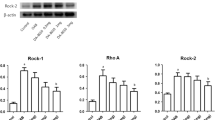Abstract
As there is increasing evidence that benign prostatic hyperplasia and its related acute urinary retention (AUR) induce over active bladder (OAB) syndrome, we investigated the effects of AUR on bladder function over a 4-week period in a rat model. Ten-week-old female Sprague-Dawley rats were used in this study. AUR was induced by clamping the distal urethra of each rat with a small clip, and then infusing 3 ml (0.6 ml/min) of saline with an infusion pump through a transurethral catheter (22G). The obstruction was sustained for 60 min and the clip was removed and then the bladder was allowed to drain through the catheter. The bladder function was estimated by voiding behavior studies (at 3 days, 1, 2, 3, and 4 weeks), cystometric studies (at 2 and 4 weeks) and organ bath studies using KCl and carbachol (at 2 and 4 weeks). Furthermore, we evaluated histological changes in the rat bladder 2 and 4 weeks after the induction of AUR. The same parameters were also measured in non-AUR rats (control group). The rat bladder weight in the AUR group at 2 weeks was significantly larger than that of the controls, and returned to the control level 4 weeks after the AUR episode. The voiding behavior studies showed significant increase in micturition frequency per day and decrease in single voiding volume 3 days after the induction of AUR, and this voiding behavior was continued for more than 2 weeks. The cystometric studies showed a significant decrease in single-voided volume at 2 weeks rat. However, no significant changes of the other parameters were observed in the rats. The histological studies showed significant infiltration of neutrophils and lymphocytes, as well as increase in turnover of epithelium in AUR rats at 2 weeks, while significant increases in fibrosis in submucosal layer were observed in AUR rats at 4 weeks. This study demonstrated that bladder dysfunction in the rat model caused by AUR needs more than 2 weeks of recovery period. The AUR-associated alterations in the bladder may represent a key clue to understand the underlying pathophysiological mechanisms, which take place in OAB syndrome.


Similar content being viewed by others
References
Choong S, Emberton E (2000) Acute urinary retention. BJU Int 85:186–201
Tammela TL, Levin RM, Monson FC, Wein AJ, Longhurst PA (1993) The influence of acute overdistension on rat bladder function and DNA synthesis. J Urol 150:1533–1539
Gabella G, Uvelius B (1999) Structural changes in the rat bladder after acute outlet obstruction. Scand J Urol Nephrol 201:32–37
Lin AT, Chen KK, Yang CH, Chang LS (2000) Mannitol facilitates rabbit urinary bladder recovery from overdistension injury. Urology 56:702–707
Saito M, Miyagawa I (2001) Bladder dysfunction after acute urinary retention in rats. J Urol 165:1745–1747
Shimizu S, Saito M, Kinoshita Y, Kazuyama E, Tamamura M, Satoh I, Satoh K (2009) Acute urinary retention and subsequent catheterization cause lipid peroxidation and oxidative DNA damage in the bladder: preventive effect of edaravone, a free-radical scavenger. BJU Int. doi:10.1111/j.1464-410X.2009.08471.x
Greenland JE, Brading AF (2001) The effect of bladder outflow obstruction on detrusor blood flow changes during the voiding cycle in conscious pigs. J Urol 165:245–248
Saito M, Kinoshita Y, Satoh I, Shinbori C, Suzuki H, Yamada M, Watanabe T, Satoh K (2007) Ability of cyclohexenonic long-chain fatty alcohol to reverse diabetes-induced cystopathy in the rat. Eur Urol 51:479–488
Saito M, Okada S, Kazuyama E, Satoh I, Kinoshita Y, Satoh K (2008) Pharmacological properties, functional alterations, and gene expression of muscarinic receptors in young and old type 2 Goto-Kakizaki diabetic rat bladders. J Urol 180:2701–2705
Kang J, Wein AJ, Levin RM (1992) Bladder functional recovery following acute overdistension. Neurourol Urodyn 11:253–260
Speakman MJ, Brading AF, Gilpin CJ, Dixon JS, Gilpin SA, Gosling JA (1987) Bladder outflow obstruction—a cause of denervation supersensitivity. J Urol 138:1461–1466
Steers WD, Ciambotti J, Etzel B, Erdman S, De Groat WC (1991) Alterations in afferent pathways from the urinary bladder of the rat in response to partial urethral obstruction. J Comp Neurol 310:401–410
Seki N, Karim OM, Mostwin JL (1992) The effect of experimental urethral obstruction and its reversal on changes in passive electrical properties of detrusor muscle. J Urol 148:1957–1961
Abrams P, Cardozo L, Fall M, Griffiths D, Rosier P, Ulmsten U, van Kerrebroeck P, Victor A, Wein A (2002) Standardisation Sub-committee of the International Continence Society. The standardisation of terminology of lower urinary tract function: report from the Standardisation Sub-committee of the International Continence Society. Neurourol Urodyn 21:167–178
Sexton CC, Coyne KS, Kopp ZS, Irwin DE, Milsom I, Aiyer LP, Tubaro A, Chapple CR, Wein AJ, EpiLUTS Team (2009) The overlap of storage, voiding and postmicturition symptoms and implications for treatment seeking in the USA, UK and Sweden: EpiLUTS. BJU Int 103(Suppl 3):12–23
Saito M, Wada K, Kamisaki Y, Miyagawa I (1998) Effect of ischemia reperfusion on contractile function of rat urinary bladder: possible role of nitric oxide. Life Sci 62:PL149–PL156
McMurray G, Casey JH, Naylor AM (2006) Animal models in urological disease and sexual dysfunction. Br J Pharmacol 147(Suppl 2):S62–S79
Acknowledgments
This study was supported by a grant in aid from the Ministry of Education, Science, and Culture of Japan (#20591880).
Author information
Authors and Affiliations
Corresponding author
Rights and permissions
About this article
Cite this article
Saito, M., Shimizu, S., Kinoshita, Y. et al. Bladder dysfunction after acute urinary retention in the rats: a novel over active bladder model. Mol Cell Biochem 333, 109–114 (2010). https://doi.org/10.1007/s11010-009-0210-6
Received:
Accepted:
Published:
Issue Date:
DOI: https://doi.org/10.1007/s11010-009-0210-6




